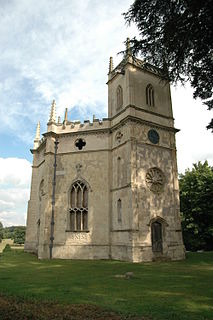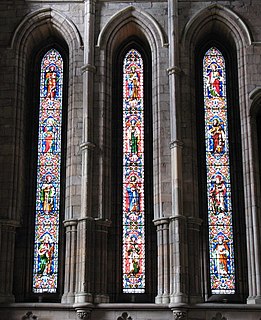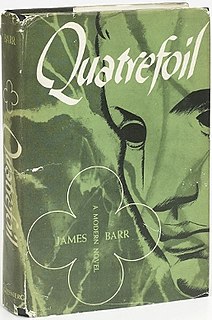
Hartwell is a village and former civil parish, now in the parish of Stone with Bishopstone and Hartwell, in the Aylesbury Vale district, in central Buckinghamshire, England. It is to the south of Aylesbury, by the village of Stone. In 1961 the civil parish had a population of 100.

A lancet window is a tall, narrow window with a pointed arch at its top. It acquired the "lancet" name from its resemblance to a lance. Instances of this architectural motif are typical of Gothic church edifices of the earliest period. Lancet windows may occur singly, or paired under a single moulding, or grouped in an odd number with the tallest window at the centre.

A Multifoil arch is a style of arch that was an architectural element in the Moorish architecture of al-Andalus.

Brezje nad Kamnikom is a settlement in the Municipality of Kamnik in the Upper Carniola region of Slovenia.

A claymore is either the Scottish variant of the late medieval two-handed sword or the Scottish variant of the basket-hilted sword. The former is characterised as having a cross hilt of forward-sloping quillons with quatrefoil terminations and was in use from the 15th to 17th centuries.

The First Baptist Church of Ossining is located in the center of the village of Ossining, New York, United States. It is a brick building in the Gothic Revival architectural style with a tall wooden steeple built in the 1870s, one of Ossining's most prominent landmarks. In 1973 it was listed on the National Register of Historic Places. Sixteen years later, in 1989, it was included as a contributing property to the Downtown Ossining Historic District when it was listed on the Register.

All Saints Church is a redundant Anglican church in the village of Theddlethorpe, Lincolnshire, England. It is recorded in the National Heritage List for England as a designated Grade listed building, and is under the care of the Churches Conservation Trust. The church stands to the east of the A1031 road in the area of the village named Theddlethorpe All Saints, and is some 3 miles (5 km) northeast of Mablethorpe. It has been called the "Cathedral of the Marsh".

Holy Trinity Church is in the village of Hoghton, Lancashire, England. It is an active Anglican parish church in the deanery of Leyland, the archdeaconry of Blackburn, and the diocese of Blackburn. The church is recorded in the National Heritage List for England as a designated Grade II listed building. It is a Commissioners' church, having received a grant towards its construction from the Church Building Commission.

St John and the Holy Cross Church is in Stable Lane, Cotebrook, Cheshire, England. It is an active Anglican church in the parish of Tarporley, the deanery of Malpas, the archdeaconry of Chester, and the diocese of Chester. It is a daughter church of St Helen, Tarporley with St Thomas, Eaton. The church is recorded in the National Heritage List for England as a designated Grade II listed building.

St Mary's Church is in St Mary's Street, Crewe, Cheshire, England. It is an active Roman Catholic parish church in the diocese of Shrewsbury. The church is recorded in the National Heritage List for England as a designated Grade II listed building.

St John the Evangelist's Church is in Toft Road, Toft, Cheshire, England. It is an active Anglican parish church in the deanery of Knutsford, the archdeaconry of Macclesfield, and the diocese of Chester. Its benefice is combined with that of St John the Baptist, Knutsford. The church is recorded in the National Heritage List for England as a designated Grade II listed building.
The Archives, Libraries, Museums and Special Collections (ALMS) Conference is an international event focussed on the work by public, private, academic, and grassroots organisations which are collecting, capture and preserving archives of LGBTQ+ experiences, to ensure their histories continue to be documented and share

The Arthur Hillyer Ford House is a historic building located in Iowa City, Iowa, United States. Ford was a Chicago native who worked as an electrical engineer before becoming a college professor. He eventually became Professor of Electrical Engineering at the University of Iowa, and is credited with inventing glare-less automobile headlights. He hired local architect Orville H. Carpenter to design his Mission Revival house. It features a symmetrical composition, wall dormers with scalloped parapets, a quatrefoil window, stuccoed walls, red clay tile roof with wide overhanging eaves, and a full-length front porch with square piers and flattened arches. The American Craftsman influence is found on the interior, especially in the fireplace inglenook. The house was individually listed on the National Register of Historic Places in 1986. In 1994 it was included as a contributing property in the Brown Street Historic District.
James Fugaté was an author and activist in the gay rights movement. Fugaté wrote several works under the pseudonym James Barr. He is well-known for his two novels, short stories, a play, and writings in three reputable gay publications.















